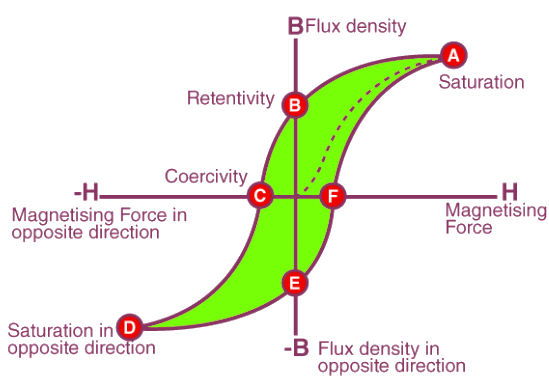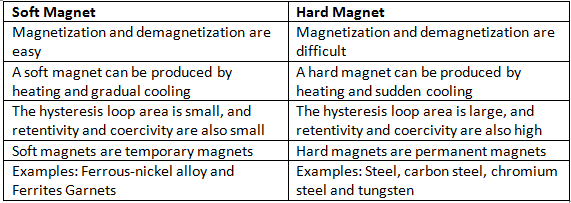Ferromagnetic Material | Physics Optional Notes for UPSC PDF Download
What Is Ferromagnetism?
Ferromagnetism, derived from the Latin word "ferrum" meaning iron, refers to the magnetic behavior first observed in iron. It is a property exhibited by certain materials like iron, cobalt, nickel, and their alloys, where they develop permanent magnetism or strongly attract magnetic fields. This phenomenon involves electrically uncharged materials displaying strong mutual attraction, influenced by their chemical composition, microstructure, and crystalline structure.
Causes of Ferromagnetism
In an unmagnetized ferromagnetic material, tiny regions called domains contain atomic dipoles aligned in the same direction, creating a net magnetic moment without an external field. However, adjacent domains typically have opposing magnetic moments, canceling each other out, resulting in no net magnetism. When an external magnetic field is applied, these domains align with the field, strongly magnetizing the material in the direction of the applied field.
Ferromagnetic Materials
Ferromagnetic materials are substances that exhibit strong magnetism in the direction of an applied magnetic field due to the alignment of their atomic structures, which act like miniature electromagnets. Examples include metals like iron, cobalt, and nickel, as well as metallic alloys and rare earth magnets. Magnetite, an iron oxide, is a naturally occurring ferromagnetic material with a Curie temperature of 580°C and the strongest magnetism among natural minerals.
Properties of Ferromagnetic Materials
- Atomic Dipole Alignment: Atoms in ferromagnetic materials have permanent dipole moments aligned within domains, parallel to an external magnetic field.
- High Magnetization: The magnetization intensity (M) is large, positive, and proportional to the magnetizing field (H), with saturation depending on the material.
- High Magnetic Susceptibility: Susceptibility (Xm = M/H) is very large and positive.
- Dense Magnetic Flux: Magnetic flux density (B = ε₀(H + M)) is large and positive, with dense field lines inside the material.
- High Permeability: Relative permeability is large, making the internal field much stronger than the external field.
- Strong Attraction: Ferromagnetic materials are strongly attracted to magnetic fields, sticking to poles in nonuniform fields.
- Behavior in Powder Form: Ferromagnetic powder accumulates at the poles and shows a depression in the middle due to the strongest field at the poles.
- Temperature Sensitivity: Ferromagnetic properties are lost when the material is liquefied due to high temperatures.
Hysteresis
When the external magnetic field is removed, ferromagnetic materials retain some magnetization, a phenomenon known as hysteresis. To fully demagnetize the material, a reverse magnetic field must be applied. Plotting magnetic flux density (B) against the magnetizing field intensity (H) produces a hysteresis loop, where:
- Retentivity: The residual magnetic flux density when the magnetizing field is zero.
- Coercivity: The reverse field strength required to fully demagnetize the material.
Curie Temperature
Ferromagnetism is temperature-dependent. Above a specific temperature, known as the Curie temperature (Tc), ferromagnetic materials transition to paramagnetic behavior.
Applications of Ferromagnetic Materials
Ferromagnetic materials are widely used in electric motors, generators, transformers, telephones, loudspeakers, and magnetic stripes on credit cards due to their strong magnetic properties.
What Is Hysteresis?
Hysteresis, meaning "lagging," describes the delay between magnetic flux density (B) and magnetic field strength (H) in ferromagnetic materials. For example, when a ferromagnetic material is placed in a current-carrying coil, it magnetizes. Reversing the current demagnetizes the material, and this lag is hysteresis. Hysteresis is a nonlinear phenomenon, often modeled mathematically using frameworks like the Preisach, Bouc–Wen, or Jiles–Atherton models.
Types of Hysteresis
- Rate-Dependent Hysteresis: A lag exists between input and output, such as a phase lag in sinusoidal signals.
- Rate-Independent Hysteresis: The system retains a persistent memory of past states after transients fade.
Rate-dependent hysteresis: In this type of hysteresis, there is a lag between input and output. We can take the example of a sinusoidal input X(t) resulting in a sinusoidal output Y(t), there is a phase lag φ: 
Rate-independent hysteresis: This hysteresis found in systems tend to have a persistent memory of the past that still remains even after the transients have disappeared.
Hysteresis Loop
The hysteresis loop shows the relationship between the magnetic flux density and the magnetizing field strength. The loop is generated by measuring the magnetic flux coming out from the ferromagnetic substance while changing the external magnetizing field.

Looking at the graph, if B is measured for various values of H and if the results are plotted in graphic forms, then the graph will show a hysteresis loop.
- The magnetic flux density (B) is increased when the magnetic field strength (H) is increased from 0 (zero).
- With an increase in the magnetic field, there is an increase in the value of magnetism, and it finally reaches point A, which is called the saturation point where B is constant.
- With a decrease in the value of the magnetic field, there is a decrease in the value of the magnetism. But if B and H are equal to zero, when a substance or material retains some amount of magnetism, it is called retentivity or residual magnetism.
- When there is a decrease in the magnetic field towards the negative side, magnetism also decreases. At point C, the substance is completely demagnetized.
- The force required to remove the retentivity of the material is known as Coercive force (C).
- In the opposite direction, the cycle is continued where the saturation point is D, the retentivity point is E, and the coercive force is F.
- Due to the forward and opposite direction process, the cycle is complete, and this cycle is called the hysteresis loop.
Advantages of the Hysteresis Loop
- A smaller loop indicates lower hysteresis loss.
- The loop helps determine retentivity and coercivity, aiding in material selection for permanent magnets.
- Residual magnetism can be assessed for electromagnet applications.
Retentivity and Coercivity
- Retentivity: The magnetization remaining after removing the external field, represented by point B on the hysteresis loop.
- Coercivity: The reverse field strength needed to fully demagnetize the material, shown at point C.
Applications of Hysteresis
Hysteresis is observed in fields like physics, chemistry, engineering, biology, and economics. Key applications include:
- Ferromagnetic Memory: Used in hard disks, magnetic tapes, and credit card stripes.
- Control Systems: Incorporated in thermostats and Schmitt triggers to prevent rapid switching.
- Algorithms: Intentionally used in some computational models.
- Aerodynamics: Observed in lift and drag coefficients post-stall in wings.
- Interfacial Rheology: Impacts bubble-related experiments.
- Biology: Found in cell biology, neuroscience, ecology, and more.
Energy Loss Due to Hysteresis
Hysteresis causes energy loss, particularly in transformers, where magnetization and demagnetization cycles generate heat (hysteresis loss). The energy lost per unit volume equals the area of the hysteresis loop. To minimize this, soft iron cores are used in transformers due to their lower hysteresis loss compared to other materials.
Difference between the Soft Magnet and Hard Magnet

Soft Iron vs. Steel
- Retentivity: Soft iron has higher retentivity than steel.
- Magnetization/Demagnetization: Soft iron magnetizes and demagnetizes more easily than steel.
- Coercivity: Steel has higher coercivity than soft iron.
- Hysteresis Loop Area: Soft iron has a smaller loop, indicating less energy loss.
- Magnetic Properties: Soft iron has higher magnetic permeability and susceptibility than steel.
- Applications: Soft iron is used in transformers and tape recorders; steel is used for permanent magnets.
Magnetization and Demagnetization
Magnetization is the process of inducing magnetic properties in a material using an electric current or contact with a strong magnet. When a ferromagnetic material is placed in a magnetic field, its atomic dipoles align with the field, magnetizing it. Reversing the field demagnetizes the material, demonstrating hysteresis.
FAQs on Ferromagnetic Material - Physics Optional Notes for UPSC
| 1. What is ferromagnetism and how does it differ from other types of magnetism? |  |
| 2. What are the main causes of ferromagnetism in materials? |  |
| 3. Can you name some common ferromagnetic materials and their uses? |  |
| 4. What is hysteresis and how is it related to ferromagnetic materials? |  |
| 5. What are the applications of hysteresis and the associated energy losses in ferromagnetic materials? |  |















